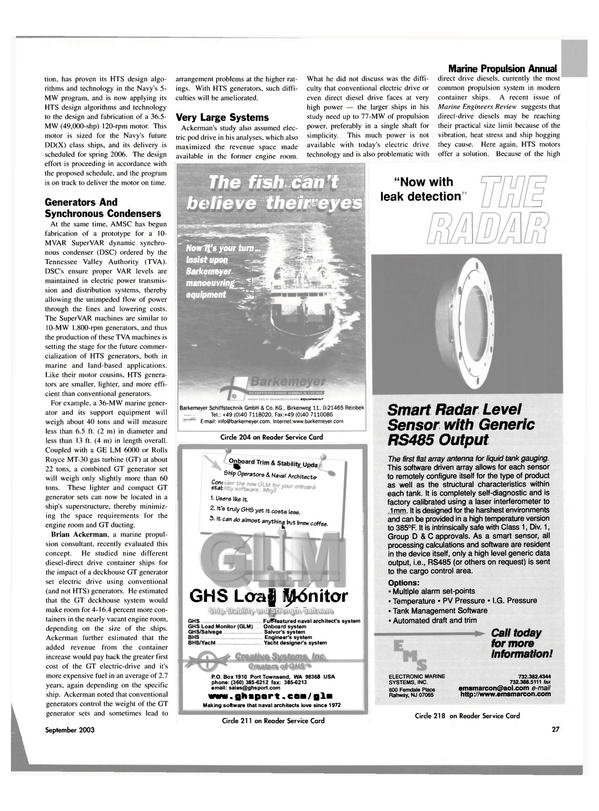
Generators And Synchronous Condensers
At the same time, AMSC has begun fabrication of a prototype for a 10- MVAR SuperVAR dynamic synchronous condenser (DSC) ordered by the Tennessee Valley Authority (TVA).
DSC's ensure proper VAR levels are maintained in electric power transmission and distribution systems, thereby allowing the unimpeded flow of power through the lines and lowering costs.
The SuperVAR machines are similar to 10-MW 1,800-rpm generators, and thus the production of these TVA machines is setting the stage for the future commercialization of HTS generators, both in marine and land-based applications.
Like their motor cousins, HTS generators are smaller, lighter, and more efficient than conventional generators.
For example, a 36-MW marine generator and its support equipment will weigh about 40 tons and will measure less than 6.5 ft. (2 m) in diameter and less than 13 ft. (4 m) in length overall.
Coupled with a GE LM 6000 or Rolls Royce MT-30 gas turbine (GT) at about 22 tons, a combined GT generator set will weigh only slightly more than 60 tons. These lighter and compact GT generator sets can now be located in a ship's superstructure, thereby minimizing the space requirements for the engine room and GT ducting.
Brian Ackerman, a marine propulsion consultant, recently evaluated this concept. He studied nine different diesel-direct drive container ships for the impact of a deckhouse GT generator set electric drive using conventional (and not HTS) generators. He estimated that the GT deckhouse system would make room for 4-16.4 percent more containers in the nearly vacant engine room, depending on the size of the ships.
Ackerman further estimated that the added revenue from the container increase would pay back the greater first cost of the GT electric-drive and it's more expensive fuel in an average of 2.7 years, again depending on the specific ship. Ackerman noted that conventional generators control the weight of the GT generator sets and sometimes lead to arrangement problems at the higher ratings.
With HTS generators, such difficulties will be ameliorated.
Read Generators And Synchronous Condensers in Pdf, Flash or Html5 edition of September 2003 Maritime Reporter
Other stories from September 2003 issue
Content
- New SWATH From ACMA page: 8
- IZAR Delivers LNG Inigo Tapias page: 10
- Wallace McGeorge Modified for Deep Dredging page: 11
- Careful, Your Species May Be Non-Indigenous page: 12
- U.S. Sub Christened in "Home" Port page: 16
- HSV 2 Swift Delivered to U.S. Navy page: 17
- A Change in Course page: 18
- Univan Reports Steady Growth page: 20
- Payload Pivotal to Fast Sealift Ship page: 24
- The Chairman's Influence on Design page: 24
- The Lure of the Electric Drive page: 26
- Very Large Systems page: 27
- Generators And Synchronous Condensers page: 27
- Cat Power For Unique Boat page: 30
- MAN B&W Flexibility With Two Strokes page: 31
- "Ink" It In: WMTC a Must for Maritime Professionals page: 34
- Guido Perla: Colombian Born, American Made page: 38
- Thrane & Thrane Offers the Capsat Fleet33 page: 42
- SeaWave Family Designed for Ease of Use page: 42
- PGS Geophysical Renews With Telenor page: 43
- Nera F 5 5 Terminal Gets Inmarsat Type Approval page: 44
- Monitoring Technology...Advanced page: 45
- Outlook for Floating Production Systems page: 52
- Meyer Werft Delivers to RCCL page: 57


